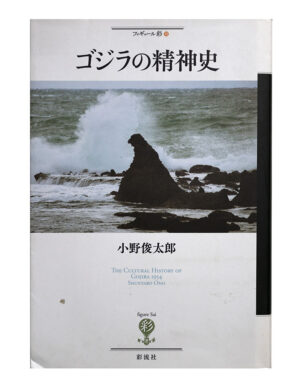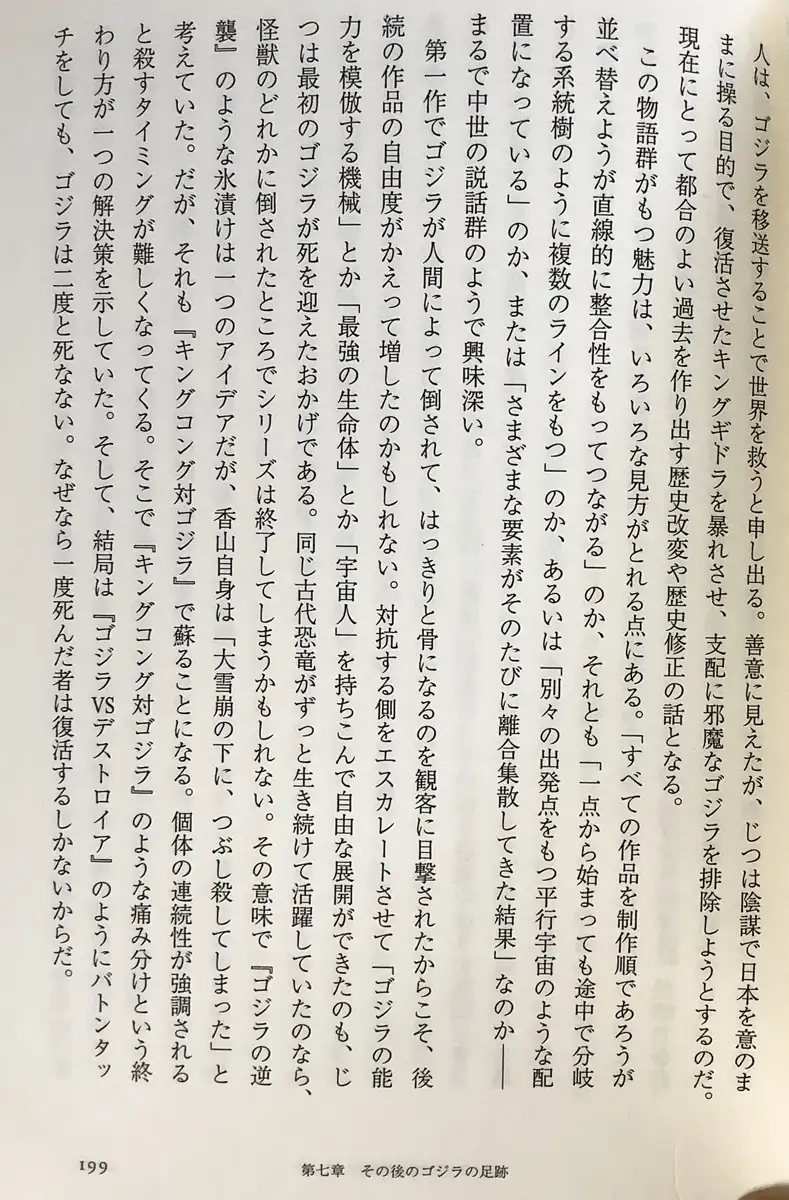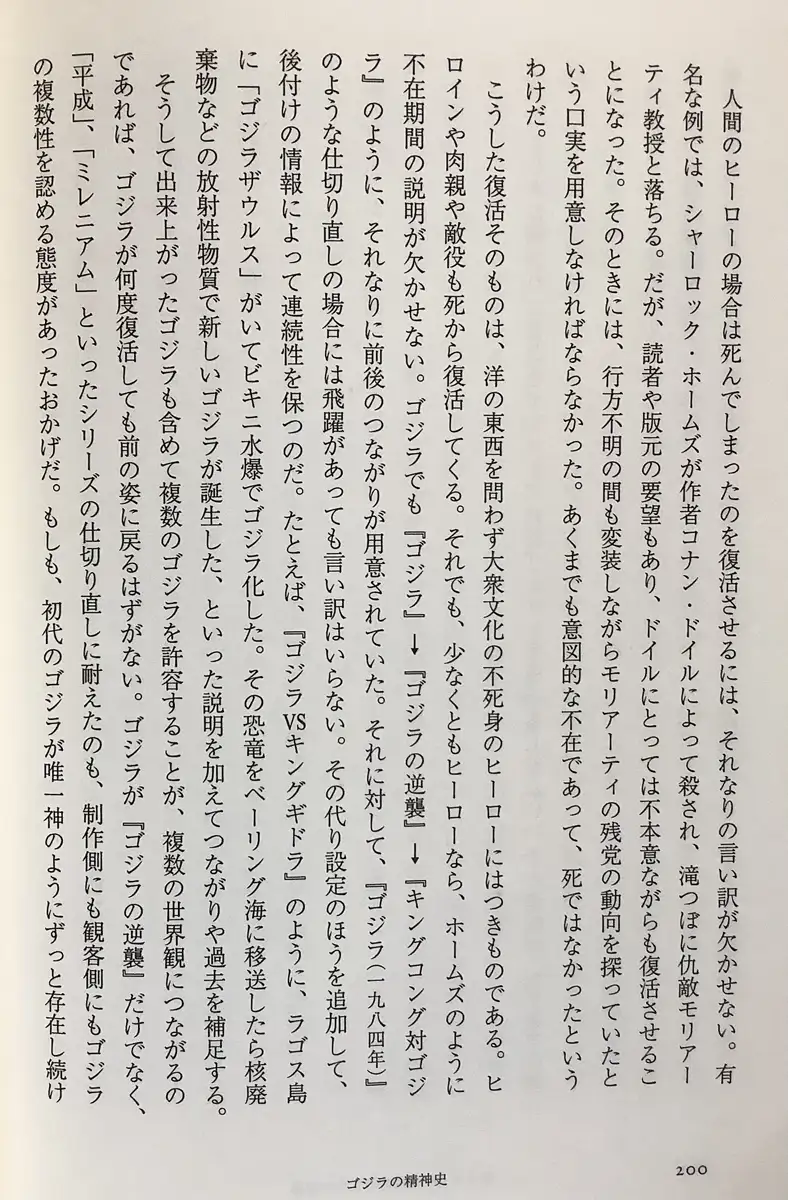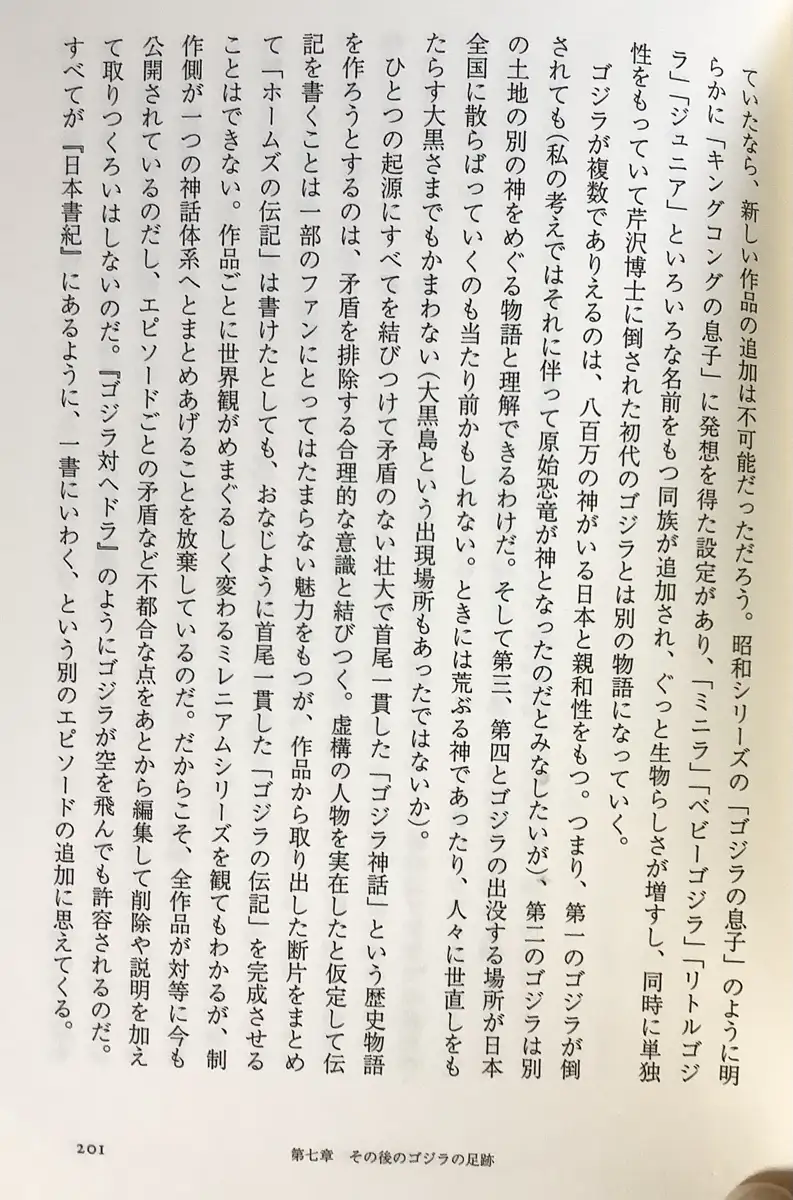9.20.2023
The Cultural History of Godzilla Introduction – Pt 73


P 199
人は、ゴジラを移送することで世界を救うと申し出る。善意に見えたが、じつは陰謀で日本を意のままに操る目的で、復活させたキングギドラを暴れさせ、支配に邪魔なゴジラを排除しようとするのだ。現在にとって都合のよい過去を作り出す歴史改変や歴史修正の話となる。
The humans offer to save the world by transporting Godzilla. It may seem like he has good intentions, but in reality, he uses a conspiracy to manipulate Japan to his will, causing the revived King Ghidorah to go on a rampage to eliminate Godzilla, who is in the way of his rule. This is a story about altering history and revising history to create a past that is convenient for the present.
この物語群がもつ魅力は、いろいろな見方がとれる点にある。「すべての作品を制作順であろうが並べ替えようが直線的に整合性をもってつながる」のか、それとも「一点から始まっても途中で分岐する系統樹のように複数のラインをもつ」のか、あるいは「別々の出発点をもつ平行宇宙のような配置になっている」のか、または「さまざまな要素がそのたびに離合集散してきた結果」なのかまるで中世の説話群のようで興味深い。
The appeal of this group of stories lies in the fact that they can be viewed in a variety of ways. Are all works connected in a straight line and with consistency, regardless of the order in which they were produced or rearranged, or do they have multiple lines like a family tree that branches off in the middle even if they start from one point? Is it “arranged like parallel universes with different starting points,” or “the result of various elements dispersing and dispersing each time?” It’s interesting, like a group of medieval fables.
第一作でゴジラが人間によって倒されて、はっきりと骨になるのを観客に目撃されたからこそ、後続の作品の自由度がかえって増したのかもしれない。対抗する側をエスカレートさせて「ゴジラの能力を模倣する機械」とか「最強の生命体」とか「宇宙人」を持ちこんで自由な展開ができたのも、じつは最初のゴジラが死を迎えたおかげである。同じ古代恐竜がずっと生き続けて活躍していたのなら、怪獣のどれかに倒されたところでシリーズは終了してしまうかもしれない。その意味で『ゴジラの逆襲』のような氷漬けは一つのアイデアだが、香山自身は「大雪崩の下に、つぶし殺してしまった」と考えていた。だが、それも『キングコング対ゴジラ」で蘇ることになる。個体の連続性が強調されると殺すタイミングが難しくなってくる。そこで『キングコング対ゴジラ』のような痛み分けという終わり方が一つの解決策を示していた。そして、結局は『ゴジラVSデストロイア』のようにバトンタッチをしても、ゴジラは二度と死なない。なぜなら一度死んだ者は復活するしかないからだ。
Perhaps it was precisely because the audience witnessed Godzilla being defeated by humans and clearly reduced to bones in the first film that subsequent films had more freedom. It was actually thanks to the death of the first Godzilla that they were able to escalate their opposition and bring in “machines that imitate Godzilla’s abilities,” “the strongest life forms,” and “alien”… If the same ancient dinosaur had been alive and active for a long time, the series might have ended if it was defeated by one of the monsters. In that sense, ice-packing like in “Godzilla Raids Again” was one idea, but Kayama himself thought “I crushed him to death under a huge avalanche.” However, that too will be revived in “King Kong vs. Godzilla.” When the continuity of individuals is emphasized, it becomes difficult to decide when to kill them. One solution to this problem was to end the story in a way similar to “King Kong vs. Godzilla,” where the pain was shared. And in the end, even if they pass the baton like in Godzilla vs. Destoroyah, Godzilla will never die again. Because once someone dies, they have no choice but to be resurrected.

P 200
人間のヒーローの場合は死んでしまったのを復活させるには、それなりの言い訳が欠かせない。有名な例では、シャーロック・ホームズが作者コナン・ドイルによって殺され、滝つぼに仇敵モリアーティ教授と落ちる。だが、読者や版元の要望もあり、ドイルにとっては不本意ながらも復活させることになった。そのときには、行方不明の間も変装しながらモリアーティの残党の動向を探っていたという口実を用意しなければならなかった。あくまでも意図的な不在であって、死ではなかったというわけだ。
In the case of human heroes, a certain excuse is essential in order to revive a dead hero. In a famous example, Sherlock Holmes is killed by author Conan Doyle and falls into a waterfall with his nemesis Professor Moriarty. However, due to requests from readers and publishers, Doyle was reluctant to revive it. At that time, he had to come up with an excuse that he had been spying on Moriarty’s remnants while he was missing, disguised. His absence was intentional, and he was not dead.
こうした復活そのものは、洋の東西を問わず大衆文化の不死身のヒーローにはつきものである。ヒロインや肉親や敵役も死から復活してくる。それでも、少なくともヒーローなら、ホームズのように不在期間の説明が欠かせない。ゴジラでも『ゴジラ』『ゴジラの逆襲』->『キングコング対ゴジラ』のように、それなりに前後のつながりが用意されていた。それに対して、『ゴジラ(一九八四年)』のような仕切り直しの場合には飛躍があっても言い訳はいらない。その代り設定のほうを追加して、後付けの情報によって連続性を保つのだ。たとえば、『ゴジラVSキングギドラ』のように、ラゴス島に「ゴジラザウルス」がいてビキニ水爆でゴジラ化した。その恐竜をベーリング海に移送したら核廃棄物などの放射性物質で新しいゴジラが誕生した、といった説明を加えてつながりや過去を補足する。
This kind of resurgence is common to the immortal heroes of popular culture, both in the East and the West. The heroine, her immediate family, and even the villain come back from the dead. Still, at least if you’re a hero, like Holmes, it’s essential to explain your period of absence. Even in Godzilla, there were some connections before and after, like “Godzilla” and “Godzilla Raids Again” -> “King Kong vs. Godzilla.” On the other hand, in the case of a reboot like Godzilla (1984), there is no need for excuses even if there is a leap forward. Instead, they add settings and maintain continuity through retrofitted information. For example, in “Godzilla vs. King Ghidorah,” there was a “Godzillasaurus” on Lagos Island that was transformed into Godzilla by a bikini hydrogen bomb. Add the explanation that a new Godzilla was born from radioactive materials such as nuclear waste when the dinosaur was transported to the Bering Sea, and supplement the connection and past.
そうして出来上がったゴジラも含めて複数のゴジラを許容することが、複数の世界観につながるのであれば、ゴジラが何度復活しても前の姿に戻るはずがない。ゴジラが『ゴジラの逆襲』だけでなく、「平成」、「ミレニアム」といったシリーズの仕切り直しに耐えたのも、制作側にも観客側にもゴジラの複数性を認める態度があったおかげだ。もしも、初代のゴジラが唯一神のようにずっと存在し続けていたなら、新しい作品の追加は不可能だっただろう。
If allowing multiple Godzillas, including the Godzilla created in this way, leads to multiple worldviews, then no matter how many times Godzilla is revived, there is no way he will return to his previous form. The reason that Godzilla endured not only “Godzilla Raids Again,” but also series revisions such as “Heisei” and “Millennium,” is because both the producers and the audience had an attitude that acknowledged Godzilla’s plurality. If the original Godzilla had continued to exist like the only god, it would have been impossible to add new works.

P 201
昭和シリーズの「ゴジラの息子」のように明らかに「キングコングの息子」に発想を得た設定があり、「ミニラ」「ベビーゴジラ」「リトルゴジラ」「ジュニア」といろいろな名前をもつ同族が追加され、ぐっと生物らしさが増すし、同時に単独性をもっていて芹沢博士に倒された初代のゴジラとは別の物語になっていく。
Like “Godzilla’s Son” in the Showa series, the setting is clearly inspired by “Son of Kong,” and the same family has various names such as “Minya,” “Baby Godzilla,” “Little Godzilla and “Junior.” With the addition of Godzilla, it becomes much more like a creature, and at the same time, it has a sense of independence and becomes a story different from the original Godzilla, who was defeated by Dr. Serizawa.
ゴジラが複数でありえるのは、八百万の神がいる日本と親和性をもつ。つまり、第一のゴジラが倒されても(私の考えではそれに伴って原始恐竜が神となったのだとみなしたいが)、第二のゴジラは別の土地の別の神をめぐる物語と理解できるわけだ。そして第三、第四とゴジラの出没する場所が日本全国に散らばっていくのも当たり前かもしれない。ときには荒ぶる神であったり、人々に世直しをもたらす大黒さまでもかまわない(大黒島という出現場所もあったではないか)。
The fact that there can be multiple Godzillas has an affinity with Japan, where there are eight million gods. In other words, even if the first Godzilla is defeated (in my opinion, I would like to assume that the primitive dinosaurs became gods), the second Godzilla will be a story about another god from another land. That’s understandable. And it may be natural that the third and fourth locations where Godzilla appears are scattered all over Japan. Sometimes it’s a savage god, or sometimes it’s Daikoku [god of wealth], who brings people reform (I think there was also a place where he appeared, Daikoku Island).
ひとつの起源にすべてを結びつけて矛盾のない壮大で首尾一貫した「ゴジラ神話」という歴史物語を作ろうとするのは、矛盾を排除する合理的な意識と結びつく。虚構の人物を実在したと仮定して伝記を書くことは一部のファンにとってはたまらない魅力をもつが、作品から取り出した断片をまとめて「ホームズの伝記」は書けたとしても、おなじように首尾一貫した「ゴジラの伝記」を完成させることはできない。作品ごとに世界観がめまぐるしく変わるミレニアムシリーズを観てもわかるが、制作側が一つの神話体系へとまとめあげることを放棄しているのだ。だからこそ、全作品が対等に今も公開されているのだし、エピソードごとの矛盾など不都合な点をあとから編集して削除や説明を加えて取りつくろいはしないのだ。「ゴジラ対ヘドラ』のようにゴジラが空を飛んでも許容されるのだ。すべてが『日本書紀』にあるように、一書にいわく、という別のエピソードの追加に思えてくる。
The attempt to connect everything to a single origin and create a grand and coherent historical story called the “Godzilla myth” without contradictions is connected with a rational consciousness that eliminates contradictions. Writing a biography of a fictional character based on the assumption that he actually existed has irresistible appeal for some fans, but even if you could write a “Holmes biography” by putting together fragments taken from the work, it would not be as successful. It is impossible to complete a coherent “biography of Godzilla.” As you can see from watching the Millennium series, where the worldview changes rapidly with each work, the producers have abandoned the idea of consolidating them into a single mythical system. That’s why all works are still made available to the public on an equal basis, and we don’t edit out inconveniences such as inconsistencies between episodes later by adding deletions or explanations. It’s acceptable for Godzilla to fly through the sky, like in “Godzilla vs. Hedorah.” Everything seems to be added to another episode in one book, just as it is in the Nihon Shoki.
The Nihon Shoki, sometimes translated as The Chronicles of Japan, is the second-oldest book of classical Japanese history. The book is also called the Nihongi. (Source: Wikipedia)